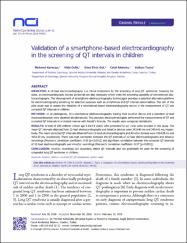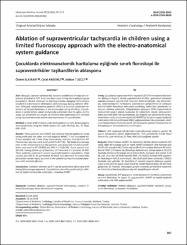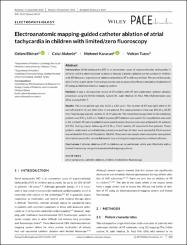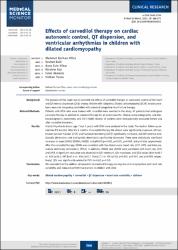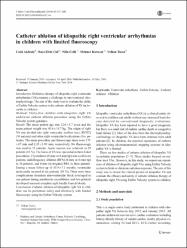Ara
Toplam kayıt 10, listelenen: 1-10
Validation of a smartphone-based electrocardiography in the screening of QT intervals in children
(Kare Publishing, 2019)
OBJECTIVE: A 12-lead electrocardiography is a critical component for the screening of long QT syndrome; however, besides, an electrocardiograph, trained personnel are also necessary which limits the screening capability ...
Çocuklarda elektroanatomik haritalama eşliğinde sınırlı floroskopi ile supraventriküler taşikardilerin ablasyonu
(Logos Medical Publishing, 2018)
Amaç: Çocuklarda supraventriküler taşikardi (SVT)’lerin tedavisinde kateter ablasyon başarılı olarak uygulanmakla birlikte, geleneksel yöntemleyapılan ablasyon işlemlerinde X-ışınları kullanılmaktadır. Son dönemlerde, ...
Cryoablation with an 8-mm-Tip -catheter for right-sided accessory pathways in children
(Wiley-Blackwell, 2016)
BackgroundCryoablation is increasingly utilized in children because of its safety profile. Recently, larger catheter tips have been more widely used to improve long-term success rates. The aim of this study was to assess ...
Electroanatomic mapping-guided catheter ablation of atrial tachycardia in children with limited/zero fluoroscopy
(Wiley, 2019)
Introduction Atrial tachycardia (AT) is an uncommon cause of supraventricular tachycardia in children and it is often resistant to medical therapy. Catheter ablation can be curative in children with AT. However, experience ...
Assessment of atrioventricular conduction following cryoablation of atrioventricular nodal reentrant tachycardia in children
(Wiley-Blackwell, 2014)
Background Early-onset transient atrioventricular block (AVB) is a rare occurrence following cryoablation of atrioventricular nodal reentrant tachycardia (AVNRT), despite lack of any AVB at the end of the procedure. The ...
Electroanatomic mapping guided cryoablation of Mahaim pathways in children with limited fluoroscopy exposure
(Blackwell Publishing, 2015)
BackgroundThe presence of Mahaim accessory pathways (MAP) with anterograde decremental conduction is a disorder that leads to antidromic atrioventricular reentrant tachycardia. There are rare reports of cryoablation use ...
Long-termoutcomes following cryoablation of atrioventricular nodal reentrant tachycardia in children
(Wiley, 2018)
BackgroundAtrioventricular nodal reentrant tachycardia (AVNRT) is a common tachyarrhythmia substrate inchildren, which is successfully treated by catheter ablation using radiofrequency or cryothermal energy. In recent ...
Catheter ablation of left posterior fascicular ventricular tachycardia in children with limited fluoroscopy exposure
(Cambridge University Press, 2019)
Introduction:Catheter ablation of left posterior fascicular ventricular tachycardia in the pediatric population remains challenging, and most studies about this topic have been conducted on adult patients. This study aimed ...
Effects of carvedilol therapy on cardiac autonomic control, QT dispersion, and ventricular arrhythmias in children with dilated cardiomyopathy
(2013)
The purpose of this study was to examine the effects of carvedilol therapy on autonomic control of the heart and QT-interval dispersion (QTd) among children with idiopathic dilated cardiomyopathy (DCM) whose symptoms were ...
Catheter ablation of idiopathic right ventricular arrhythmias in children with limited fluoroscopy
(Springer, 2016)
Introduction Definitive therapy of idiopathic right ventricular arrhythmias (VA) remains a challenge in interventional electrophysiology. The aim of this study was to evaluate the utility of EnSite Velocity system in the ...

